
The Pre-Wedding Phase
The Wedding Day
The Post-Wedding Phase
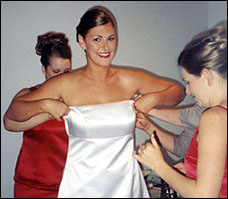 Dressing Dressing
Most weddings take place on Saturday. The bride and groom are usually dressed
in a white wedding dress and black suit. Some Ukrainian elements are sometimes
integrated into their clothing. For example, in some cases, the bride wears a
bridal headpiece in the shape of a vinok or wreath. Although the shape of the
wreath may be changed, its use may relate back to the traditional
vinkopletennia. More overt examples of Ukrainianess are found in some wedding
receptions in this period. Besides the bride's headpiece, the embroidery on the
bride's dress as well as on the groom's jacket and shirt expresses Ukrainianess.
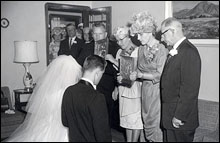 Blessing
[blahoslovennia] Blessing
[blahoslovennia]
A ritual blessing of the bride and groom by their parents is sometimes
performed shortly before the church ceremony. It may be done separately for the
bride at the home of her parents, and for the groom at the home of his parents,
or it may be combined. Generally, the bride and groom kneel on an embroidered
ritual cloth [rushnyk] in front of their parents. They ask their parents to
bestow a blessing upon them for a long, healthy, happy and prosperous life. The
parents bless their children with the korovai, perhaps lifting it to touch the
heads of the young couple. Once the blessing is complete, those gathered may
sing "Mnohaia lita" ([May God grant] many happy years) for the bride and groom.
Wedding procession
The wedding cars are often decorated with paper and plastic flowers. Sometimes
the bride and groom separately rent limousines or other special vehicles for
the occasion. They drive separately to church.
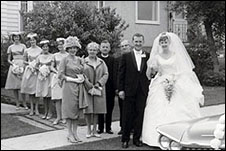
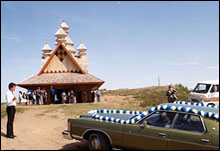
The church marriage ceremony
The marriage ceremony often takes place in the afternoon. It is sometimes a
relatively quiet affair, but often the families ask a choir to sing and many
people participate in a grand and formal ritual.
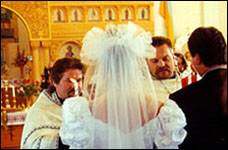 The
priest welcomes the bride and groom in the rear vestibule of the church and
blesses the wedding bands, placing them on the fingers of the bride and groom.
After affirming that they are both entering this union freely and as equals,
the bride and groom exchange their rings and follow the priest to the small
altar for their marriage rite. The script and prayers The
priest welcomes the bride and groom in the rear vestibule of the church and
blesses the wedding bands, placing them on the fingers of the bride and groom.
After affirming that they are both entering this union freely and as equals,
the bride and groom exchange their rings and follow the priest to the small
altar for their marriage rite. The script and prayers 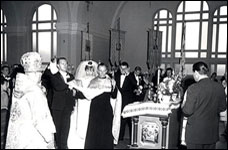 for
the church service have not changed much over the years, but some changes in
the general ceremony have taken place. The father may walk his daughter halfway
down the aisle, or he may walk her all the way. The bridal party
processing down the aisle may include a ring bearer and flower girl, as well as
two or more couples of bridesmaids and groomsmen wearing special matching
clothes. for
the church service have not changed much over the years, but some changes in
the general ceremony have taken place. The father may walk his daughter halfway
down the aisle, or he may walk her all the way. The bridal party
processing down the aisle may include a ring bearer and flower girl, as well as
two or more couples of bridesmaids and groomsmen wearing special matching
clothes.
Video 1: Parents walking the bride down the aisle (1.8mb)
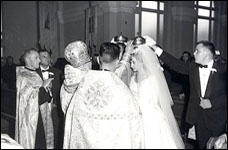 In
Ukrainian churches, some tendency remains to use the Ukrainian language during
the ceremony, though English is increasingly dominant. In
Ukrainian churches, some tendency remains to use the Ukrainian language during
the ceremony, though English is increasingly dominant.
During the ceremony, the starosty or special icon bearers carry the icons of
Jesus and Mother of God that will be placed in the home of the married couple
and serve as the spiritual centre of the household. The bride and groom 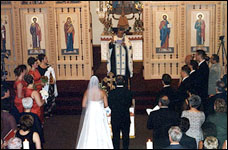 kneel
on a rushnyk, place their right hands on the Gospel and exchange wedding vows.
One of the sacred and interesting parts of the church ceremony is the Crowning.
The priest places crowns or wreaths on the heads of the bride and groom to
signify the dawn of a new kingdom to be ruled by the couple. Then the priest
uses an embroidered cloth, the rushnyk, to bind the hands of the bride and
groom and leads them walking around the small altar [tetrapod] three times,
symbolizing that God is at the centre of their marriage. kneel
on a rushnyk, place their right hands on the Gospel and exchange wedding vows.
One of the sacred and interesting parts of the church ceremony is the Crowning.
The priest places crowns or wreaths on the heads of the bride and groom to
signify the dawn of a new kingdom to be ruled by the couple. Then the priest
uses an embroidered cloth, the rushnyk, to bind the hands of the bride and
groom and leads them walking around the small altar [tetrapod] three times,
symbolizing that God is at the centre of their marriage.
Video 2: Crowning in the church (2.3mb)
Video 3: Walking around the small altar (3.8mb)
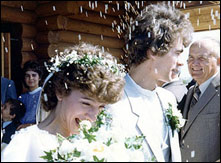 Throwing
confetti Throwing
confetti
Once the bride and groom are wed and have signed the necessary documents, they
leave the church. Awaiting them are well wishers who shower them with confetti.
However, in many cases, the church caretakers request that the confetti not be
thrown on the church grounds. In some cases, only the mother of the bride
symbolically bestows such a shower upon the couple.
Video 4: Throwing confetti (5.0mb)
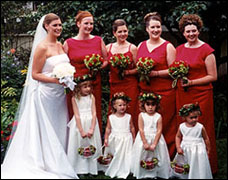 Photographs Photographs
Families typically hire a professional photographer. Immediately after the
marriage, the bridal party and members of the close family go to a picturesque
setting or studio and get formal photos taken.
Wedding reception
The reception occurs in various places, depending on the individual
circumstances, economic ability and other factors. By the 1930s and 1940s, the
Ukrainian community hall had become a popular place for the wedding reception,
rather than in family homes. Many church parishes have a hall or are equipped
for catering in the church basement.
The hall for the reception is typically decorated with flowers, balloons,
sometimes hearts, doves, rings and other symbols of love. The names of the
bride and groom are sometimes mounted on the wall behind head table. Sometimes
these decorations include Ukrainian symbolism. Some examples of
Ukrainian-themed decorations that have been used include embroidered rushnyky
as table coverings, podium decoration, and table decoration. Perwinkle
[Barvinok], myrtle [mirta], braided or woven together into wreaths and
garlands, can also be used for draping the table. Occasionally, wheat may be
decorated with flowers or ribbons, usually to match the wedding colours. Wheat
is also an important symbol in Ukrainian traditions and is used in table
decorations and has become increasingly popular in the bouquets and corsages.
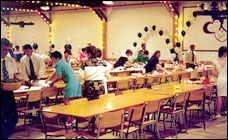 
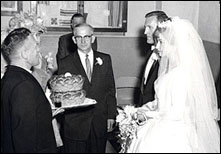
The blessing and greeting of the newlyweds
The parents of both the bride and groom may greet the couple and their wedding
party by giving them bread and salt as they enter the reception hall. After the
parents bless their children, they all share a toast and the bride and groom
toss some of the salt over their shoulders.
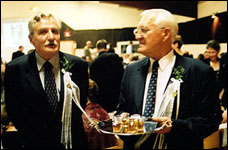 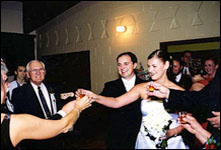
The musicians
Musicians are an essential part of most Ukrainian weddings. Especially in
western Canada, they can include a violinist, an accordionist, a drummer,
and a player on the tsymbaly. An electronic guitarist may join the band,
replacing the tsymbaly player. Until recently, it was common for the musicians
to play near the entrance to the hall as the guests arrive. Special wedding
marches are played to announce the guests. When the couple enters the hall, the
musicians usually begin a traditional Ukrainian wedding march. The bridal
couple and their attendants come in the hall following the signal from the
musician, and are greeted by the guests, who stand and clap their hands.
Throughout the night, the musicians play various kinds of music, waltzes,
polkas, and rock-and-roll.
Video 5: Guests arriving at the reception hall (Musicians at the door) (2.8mb)
Video 6: Bridal party arriving (Wedding march) (3.8mb)
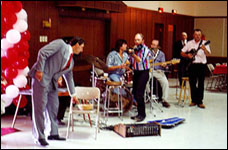 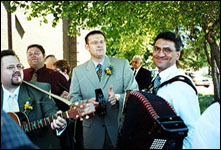
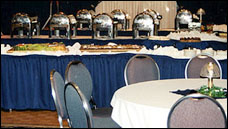 Supper Supper
Guests arrive at the reception hall at the designated time, perhaps six
o'clock. They are typically asked to sign a guest book, then visit with
acquaintances and perhaps take a drink from the bar. A large supper is served
for all the wedding guests at a designated time. Women prepare food, often
consisting of such items as chicken, cabbage rolls, kulesha, pyrohy, borshch,
broth with meat, and others. All kinds of sweets and liquor are provided. The
food varies from hall to hall as particular cooks and crews develop routines
for their work. The food tends to retain traditional elements strongly, and
often bears symbolic connection with Ukrainian identity.
Formal program and toasts
Following the meal, a formal program usually takes place. A specially
designated Master of Ceremonies steps up to a podium microphone to introduce
the people sitting at the head table. The program typically includes a toast to
the bride and another to the groom given by a member of the bridal party,
relative or friend. It also may include a welcome to either family by various
family members. The parents of both the bride and groom may stand to express
their wishes and to thank everyone for attending. It is also common for the
bride and groom themselves to address those gathered and thank everyone
involved in the entire process. At a wedding with Ukrainian elements in it, the
song "Mnohaya Lita" is sometimes sung. This format may become more or less
elaborate if the couple so wishes. It is not uncommon, in this age of
technology, for a multi-media presentation or tribute to take place in the
couple's honour. The use of Ukrainian at the reception during the greeting,
speeches, and toasts is still popular if the bride or groom understands the
language. The program sometimes ends with the cutting of the wedding cake.
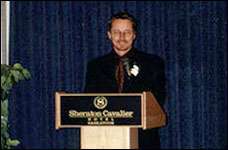 Toasts
[perepii] to the bride and groom usually take place about half way through the
evening. This may include a toast to the bride and/or groom given by a family
member or friend, often times one of the bridal party members. This also may
include a welcome to either family by various family members. Furthermore, the
parents of both the bride and groom may thank Toasts
[perepii] to the bride and groom usually take place about half way through the
evening. This may include a toast to the bride and/or groom given by a family
member or friend, often times one of the bridal party members. This also may
include a welcome to either family by various family members. Furthermore, the
parents of both the bride and groom may thank 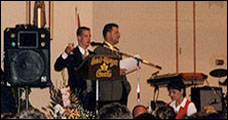 everyone
briefly for attending. And finally, it is not uncommon for the bride and groom
themselves to address those gathered and thank everyone involved in the entire
process. everyone
briefly for attending. And finally, it is not uncommon for the bride and groom
themselves to address those gathered and thank everyone involved in the entire
process.
The presentation of gifts [darovannia]
Around nine o'clock or later, the presentation of gifts takes place. The bride
and groom, as well as their party and parents stand behind the presentation
table. All the guests line up to present the bride and groom with their gifts
or cash, extending their personal wishes. Parents, relatives and close friends
usually come forth first, and then the rest of the guests follow.
Video 7: Presentation of gifts (4.1mb)
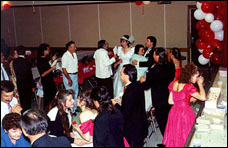 Recently,
it has become common to shift the "presentation line" to the beginning of the
reception at the hall entrance, when the guests first arrive. Recently,
it has become common to shift the "presentation line" to the beginning of the
reception at the hall entrance, when the guests first arrive.
Besides the presentation of gifts from the guests to the newlyweds, another
ritual has also been performed in recent years, the giving of gifts or wedding
favours to the guests.
The wedding favour is a symbolic memento given to friends and
relatives at the reception in appreciation of their help and support during the
wedding. These sometimes include a small card or tag with a thank you note, and
thereby replace the thank you card that had been mailed to the guests after the
wedding. Traditional Canadian wedding favours include chocolates or wrapped
mints or almonds, and can be elaborate as crystal or ceramic works. The
Ukrainianization of these wedding favours has taken the form of refrigerator
magnets in the shape of vinoks, various designs of woven wheat, small dough
doves like those on the korovai, and mini korovai.
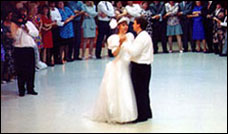 Dance Dance
After the supper, the tables are cleaned to create a rather large dance area,
generally surrounded on two or three sides by the tables, and adjoined by a
stage for the band. The newly married couple dances by themselves for the first
dance, usually a waltz or, more recently a popular love song 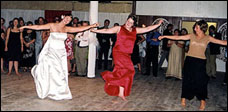 selected
by the couple. The bridal party joins in for the second dance, and the parents
of both the bride and groom join for the third dance. After this, the dance
floor is open to all of the guests for their dancing pleasure for the remainder
of the evening. The participants usually dance in couples, rarely in threesomes
for the butterfly or foursomes for the schottische, and more for the kolomyika
"birdie dance" or line dances. Typically, the bride and groom each dance with
many of the guests throughout the evening. In general, the guests dance, sit at
the tables, with their drinks, and visit. In some communities, the guests may
like to sing Ukrainian songs if the band takes a break. selected
by the couple. The bridal party joins in for the second dance, and the parents
of both the bride and groom join for the third dance. After this, the dance
floor is open to all of the guests for their dancing pleasure for the remainder
of the evening. The participants usually dance in couples, rarely in threesomes
for the butterfly or foursomes for the schottische, and more for the kolomyika
"birdie dance" or line dances. Typically, the bride and groom each dance with
many of the guests throughout the evening. In general, the guests dance, sit at
the tables, with their drinks, and visit. In some communities, the guests may
like to sing Ukrainian songs if the band takes a break.
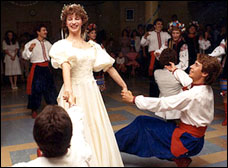 Video
8: First Dance (3.8mb) Video
8: First Dance (3.8mb)
Video 9: Butterfly (3.8mb)
Since the 1960s, a specific Canadianized form of the
kolomyika has become popular. People perform this dance in a large circle,
often surrounded by rings of less active participants. While most people stand
and clap, a series of soloists perform various dance steps in the centre of the
circle.
Video 10: Kolomyika (4.1mb)
Besides the social dancing, a Ukrainian stage dance is sometimes performed by
an invited group of dancers as a gift for the bride and groom. This dance
performance provides a strong symbol of Ukrainian community and national
identity.
Tossing the bouquet and garter
At approximately midnight, the bride and groom go up on stage and single girls
are asked to assemble in front of them. The bride turns away and throws her
flowers backward over her shoulder. Whoever catches the bouquet is said to be
next in line for getting married. The groom takes a garter off the bride's leg
and throws it to all single fellows who line up for this. The lucky male who
catches the garter is said to stand a good chance of being the next one to get
married.
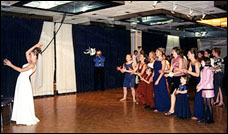 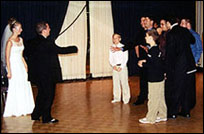
Lunch at midnight
Usually around midnight, a "lunch" is served for everyone at the wedding. This
typically consists of buns and/or bread, sandwich meat or sausage, cheese,
pickles, and often various "hot" dishes that may have been left over from the
supper. This snack is commonly set out in a buffet style, where family,
friends, guests and the bridal party can partake at their leisure.
Nuptial bed in a honeymoon suit
The reception usually ends at one o'clock or as long as the band continues to
play. In some instances, the bride and groom remain to celebrate until the end
of the reception, and in others, they leave at an earlier time. In many
communities, it is traditional for the wedding couple to perform one last dance
ceremonially before they leave. In this case, the guests all gather around the
dance floor, cross their arms and link them to form a large closed circle. They
may sing De zhoda v vodyni, Mnohaia Lita, or "For they're a jolly good couple."
The bride and groom commonly stay at a hotel in a honeymoon suite on their
wedding night.
Video 11:Last dance (4.3mb)
|




